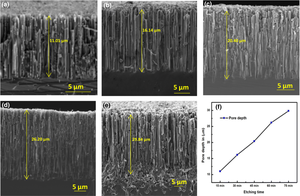
In this work, upgraded metallurgical grade silicon (UMG-Si) wafer was used to fabricate mesoporous nanostructures, as an effective antireflection layer for solar photovoltaic cells. The length of the vertical Si nanostructure (SiNS) arrays was altered by varying the etching time period during metal assisted chemical etching process, using a silver catalyst. The optical, structural, morphological changes and the antireflection properties of Si nanostructures formed on UMG-Siwafer were analysed. SEM and photoluminescence studies indicate that Si nanocrystals are formed on the surface and along the vertical nanowires. The pore size depends on the Ag nanoparticle size distribution. All the samples demonstrated a luminescence band centred around 2.2 eV. From the optical results, samples etched for 45 min show strong absorption in the visible spectrum. The minimum and maximum surface reflectance in the visible region was observed for 15 min and 60 min etched SiNS. Based on the observed results, 15 min etched Si with a uniform porous structure has minimum reflectance across the entire silicon UV–Vis absorption spectrum, making it worth further investigation as a candidate for use as an antireflection layer in silicon based solar cells.
Keywords[edit | edit source]
Black silicon; Black Si solar cell; Metal-catalyzed chemical etching; Metal-assisted chemical etching; Micro-texture; Nano-texture; Photovoltaic
See also[edit | edit source]
- MACE nano-texture process applicable for both single- and multi-crystalline diamond-wire sawn Si solar cells
- Economic Advantages of Dry-Etched Black Silicon in Passivated Emitter Rear Cell (PERC) Photovoltaic Manufacturing
- Effects of silver catalyst concentration in metal assisted chemical etching of silicon
- Advances in plasmonic light trapping in thin-film solar photovoltaic devices
- Plasmonic Perfect Meta-Absobers for a-Si PV Devices
- Multi-resonant silver nano-disk patterned thin film hydrogenated amorphous silicon solar cells for Staebler-Wronski effect compensation
- A new method of preparing highly conductive ultra-thin indium tin oxide for plasmonic-enhanced thin film solar photovoltaic devices
- Ambiance-dependent Agglomeration and Surface-enhanced Raman Spectroscopy Response of Self-assembled Silver Nano-particles for Plasmonic Photovoltaic Devices





